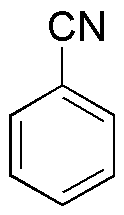Benzonitrile is widely utilized in research focused on:
- Synthesis of Pharmaceuticals: Benzonitrile serves as a key intermediate in the production of various pharmaceutical compounds, enhancing the efficiency of drug development processes.
- Organic Synthesis: It is commonly used as a solvent and reagent in organic reactions, facilitating the synthesis of complex organic molecules in laboratories.
- Polymer Manufacturing: This compound is employed in the production of specialty polymers, contributing to materials with enhanced properties for applications in coatings and adhesives.
- Electrochemical Applications: Benzonitrile is utilized in electrochemical cells, improving the performance of batteries and supercapacitors through its solvent properties.
- Analytical Chemistry: It plays a role in chromatography and spectroscopic techniques, aiding researchers in the analysis of various compounds due to its unique chemical properties.
General Information
Properties
Safety and Regulations
Applications
Benzonitrile is widely utilized in research focused on:
- Synthesis of Pharmaceuticals: Benzonitrile serves as a key intermediate in the production of various pharmaceutical compounds, enhancing the efficiency of drug development processes.
- Organic Synthesis: It is commonly used as a solvent and reagent in organic reactions, facilitating the synthesis of complex organic molecules in laboratories.
- Polymer Manufacturing: This compound is employed in the production of specialty polymers, contributing to materials with enhanced properties for applications in coatings and adhesives.
- Electrochemical Applications: Benzonitrile is utilized in electrochemical cells, improving the performance of batteries and supercapacitors through its solvent properties.
- Analytical Chemistry: It plays a role in chromatography and spectroscopic techniques, aiding researchers in the analysis of various compounds due to its unique chemical properties.
Documents
Safety Data Sheets (SDS)
The SDS provides comprehensive safety information on handling, storage, and disposal of the product.
Product Specification (PS)
The PS provides a comprehensive breakdown of the product’s properties, including chemical composition, physical state, purity, and storage requirements. It also details acceptable quality ranges and the product's intended applications.
Certificates of Analysis (COA)
Search for Certificates of Analysis (COA) by entering the products Lot Number. Lot and Batch Numbers can be found on a product’s label following the words ‘Lot’ or ‘Batch’.
*Catalog Number
*Lot Number
Certificates Of Origin (COO)
This COO confirms the country where the product was manufactured, and also details the materials and components used in it and whether it is derived from natural, synthetic, or other specific sources. This certificate may be required for customs, trade, and regulatory compliance.
*Catalog Number
*Lot Number
Safety Data Sheets (SDS)
The SDS provides comprehensive safety information on handling, storage, and disposal of the product.
DownloadProduct Specification (PS)
The PS provides a comprehensive breakdown of the product’s properties, including chemical composition, physical state, purity, and storage requirements. It also details acceptable quality ranges and the product's intended applications.
DownloadCertificates of Analysis (COA)
Search for Certificates of Analysis (COA) by entering the products Lot Number. Lot and Batch Numbers can be found on a product’s label following the words ‘Lot’ or ‘Batch’.
*Catalog Number
*Lot Number
Certificates Of Origin (COO)
This COO confirms the country where the product was manufactured, and also details the materials and components used in it and whether it is derived from natural, synthetic, or other specific sources. This certificate may be required for customs, trade, and regulatory compliance.


